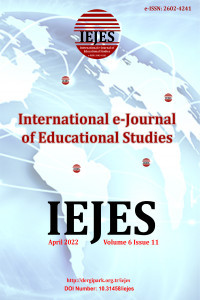Creativity of Physical Education Teachers in Modifying Learning Facilities and Infrastructure in Public Elementary Schools
Creativity, physical education teachers, modification, facilities and infrastructure
Creativity of Physical Education Teachers in Modifying Learning Facilities and Infrastructure in Public Elementary Schools
___
- Adolphus, T. (2011). Problems of teaching and learning of geometry in secondary schools in Rivers State, Nigeria. International Journal of Emerging Sciences, 1(2), 143-152.
- Arikunto, S. (2002). Prosedur penelitian suatu pendekatan praktek. Jakarta: PT Rineka Cipta.
- Azwar, S. (2005). Sikap manusia: teori dan pengukurannya. Yogyakarta: Pustaka Pelajar.
- Bailey, R., Armour, K., Kirk, D., Jess, M., Pickup, I., Sandford, R., & Education, B. P. (2009). The educational benefits claimed for physical education and school sport: an academic review. Research Papers in Education, 24(1), 1-27.
- Beutler, I. (2008). Sport serving development and peace: Achieving the goals of the United Nations through sport. Sport in Society, 11(4), 359-369.
- Lee, S. M., Burgeson, C. R., Fulton, J. E., & Spain, C. G. (2007). Physical education and physical activity: results from the School Health Policies and Programs Study 2006. Journal of School Health, 77(8), 435-463.
- Murillo, F. J., & Román, M. (2011). School infrastructure and resources do matter: analysis of the incidence of school resources on the performance of Latin American students. School Effectiveness and School Improvement, 22(1), 29-50.
- Sarjono, B. (2010). Kreativitas guru penjas dalam memodifikasi sarana dan prasarana pembelajaran di sd se-kecamatan poncowarno kabupaten kebumen (Bachelor’s thesis). Universitas Negeri Yogyakarta, Yogyakarta, Indonesian Country.
- Semiawan, C.R. (1999). Perkembangan dan belajar peserta didik. Jakarta: Depdikbud.
- Shen, B., Chen, A., & Guan, J. (2007). Using achievement goals and interest to predict learning in physical education. The Journal of Experimental Education, 75(2), 89-108.
- Slameto. (2010). Belajar dan faktor-faktor yang mempengaruhinya. Jakarta: Rineka Cipta.
- Sudijono, A. (2008). Pengantar statistika pendidikan. Jakarta: PT Raja Grafindo Persada.
- Sugiyono. (2012). Metodologi penelitian kuantitatif kualitatif dan R & D. Bandung: Alfabeta.
- Suryobroto, A.S. (2004). Diktat matakuliah sarana dan prasarana pendidikan jasmani. Yogyakarta: FIK UNY.
- Syaodih, N. (2010). Metode penelitian pendidikan. Bandung: PT Remaja Rosdakarya.
- Utama, A.M.B. (2011). Pembentukan karakter anak melalui aktivitas bermain dalam pendidikan jasmani. Jurnal Pendidikan Jasmani Indonesia, 8(1), 1-9.
- Başlangıç: 2017
- Yayıncı: Tamer KUTLUCA
Student Ability for Learning Computer Programming Languages in Primary Schools
Karzan WAKIL, Shanaz KHDIR, Lava SABIR, Lezan NAWZAD
Guli SHERVASHIDZE, Tamar SIRADZE, Lela TAVDGIRIDZE, Nani MAMULADZE
Lise Öğrencilerinin Çizimlerinden “Ödev” Kavramına ilişkin Düşüncelerinin Analizi
Gülay EKİCİ, Burcu TURGUT, Hasan AKDENİZ
The Effect of Reward and Job Satisfaction toward Turnover Intention Private Junior High School
Hardianto HARDİANTO, Rugaiyah RUGAIYAH, Unifah ROSYIDI
Relationship between Emotional Intelligence and Exam Anxiety of Higher Secondary Students
Reasons and Suggested Solutions for Low-Level Academic Achievement in Mathematics
Diyan Riski PERMATAHATI, Muhammad Nur WANGID
